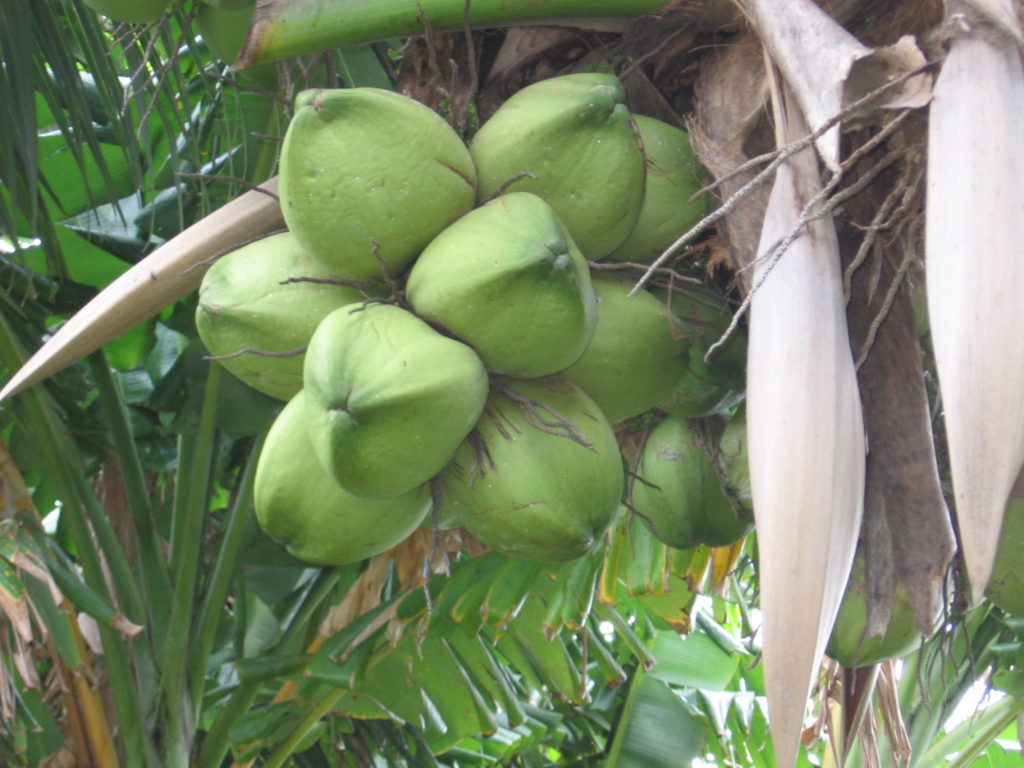Buko or Niyog

COCONUT
Cocos Nucifera L.
Niyog or coconut is not a vegetable per se, but I am including this in my book because coconut plays an integral part of our regional cooking and local cuisine.
Coconut is a tropical plant that grows best in a warm humid climate. Coastal sandy soil is suitable for planting. Soil needs to be loose and drain well.
Germination takes from three up to six months and takes at least five years to develop. The leaves frond are pinnate. Flower clusters form in the axil of each leaf. Immature flowers may drop. The remaining fruits will mature in six months, be fully ripened in nine months, and weigh about six pounds each. A healthy tree will produce at least fifty nuts per year.
Meanwhile, “buko’ is what we call the not fully ripened coconut or young coconut. The husk is green in color, and the coconut water or juice inside would be refreshingly sweet. The meat will be very tender, almost jelly-like, and very delicious. On the other hand, we call the mature coconut “niyog”. The husk will be brown in color, the juice will be somewhat bland, and the meat will be hard to scrape from the shell. We use a special grater for this to extract what we call coconut milk. After grating the meat, using a cheesecloth or bare hands, squeeze the grated coconut and the milk will be drawn. Coconut milk has so many uses in our native cuisine. We use it everywhere we need cream as a substitute. Dishes like Laing and Kaldereta would be lost without it. Desserts, so many of them I probably can not put them all on this page but my favorite would be “bibingkang kamoteng -kahoy” better known as cassava cake.
Coconut is such a very important crop in our livelihood in the Philippines. As far as I can remember, copra has been one of our leading gross national product. The oil that manufacturers get from the copra can be made as cooking oil, soaps and other beauty products.
Almost all the coconut tree parts can be used for everyday use.
Shells can be used as firewood and can be made as articles like buttons, hair clips, bowls, bras, (native dancers used in performances like hula and our native dance called “mag-lalatik”.)
The tree trunk can be used for building houses. The recently developed product called coco lumber is used to make kitchen utensils and other household furniture.
The leaves can be made into baskets or hats. We also use the leaves to wrap a local delicacy we call “suman”, a treat made of sweet glutinous rice soaked in coconut milk overnight with a little salt and then steam for a long time almost overnight on a big steamer. Burning the leaves of the coconut will also produce lime from the ashes.
The midrib of the leaves can be used to make “walis tingting” or broom for sweeping the yard.
“Coir” from the coconut husks can be used for rope making, mats, brushes, as a stuffing fiber and basket liner for hanging baskets, and other horticultural uses such as compost or mulch.
The sap from the flower clusters is collected to make “tuba” or “basi”, our local wine, or fermented to become vinegar. I remember when my Uncle Luis used to climb the coconut trees to collect this sap, and he made it into wine by putting some kind of bark that makes it into an alcoholic drink. I enjoy drinking the sap without it though. It is sweet but at the same time intoxicating.
Ubod – the heart of palm is gathered to make delicious salads or fresh lumpia, our own version of “summer roll.” Once you gather the heart of palm though, the tree will die; that is why “ubod” is considered a delicacy and also expensive.
There is also another variety of coconut we call macapuno or coconut sport. The coconut is filled with meat inside literally. This variety is the one used for making candies and desserts.
When you crack open a mature coconut with a sign of sprouting, there is a white, edible, marshmallow-like flavor shaped like an egg we call “buwa”. I enjoyed eating this when I was a kid.
Coconut water besides being a refreshing drink is used medicinally for cases of gastroenteritis, diarrhea and vomiting, against dehydration, urinary infections, antiseptic and eliminates poisons through the kidneys in case of mineral poisoning.